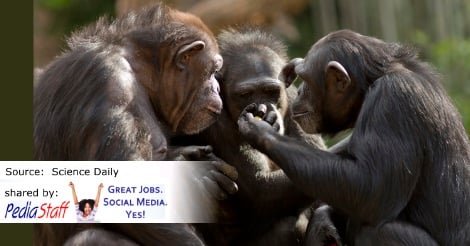Can Chimpanzee Vocalizations Reveal the Origins of Human Language?
[Source: Science Daily]

It’s very difficult to determine when, how and why human language began. While fossil primates provide important clues about human evolution, the sounds they made and the soft tissue involved in making those sounds weren’t preserved.
But chimpanzees — one of our closest living relatives — provide important points of comparison for inferring the sorts of sounds our early ancestors may have made. During the 175th Meeting of the Acoustical Society of America, being held May 7-11, 2018, in Minneapolis, Minnesota, Michael Wilson, an associate professor at the University of Minnesota, will present his group’s work searching for similarities between the vocal communications of chimpanzees and humans.
“Chimpanzees give a range of different calls: hoots, pant-hoots, pant-grunts, pant-barks, rough-grunts, nest-grunts, alarm barks, waa-barks, wraas, screams, copulation screams, and soft panting play sounds (a.k.a. laughter),” Wilson said. “Many of these calls grade into one another, and it can be difficult to categorize particular examples of some calls.”
PediaStaff is Hiring!
All JobsPediaStaff hires pediatric and school-based professionals nationwide for contract assignments of 2 to 12 months. We also help clinics, hospitals, schools, and home health agencies to find and hire these professionals directly. We work with Speech-Language Pathologists, Occupational and Physical Therapists, School Psychologists, and others in pediatric therapy and education.
